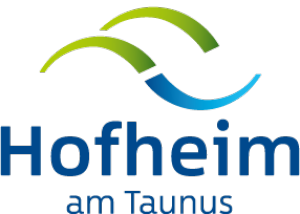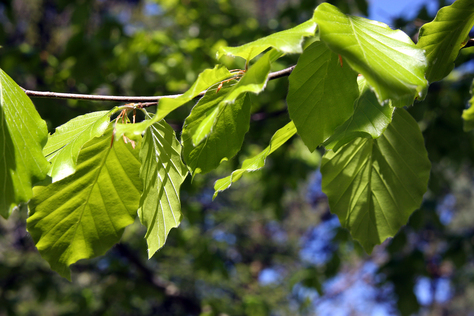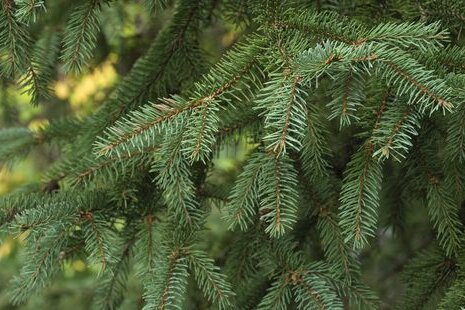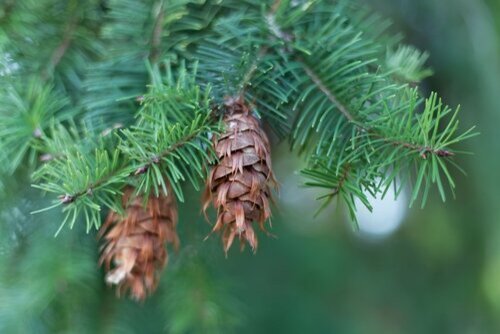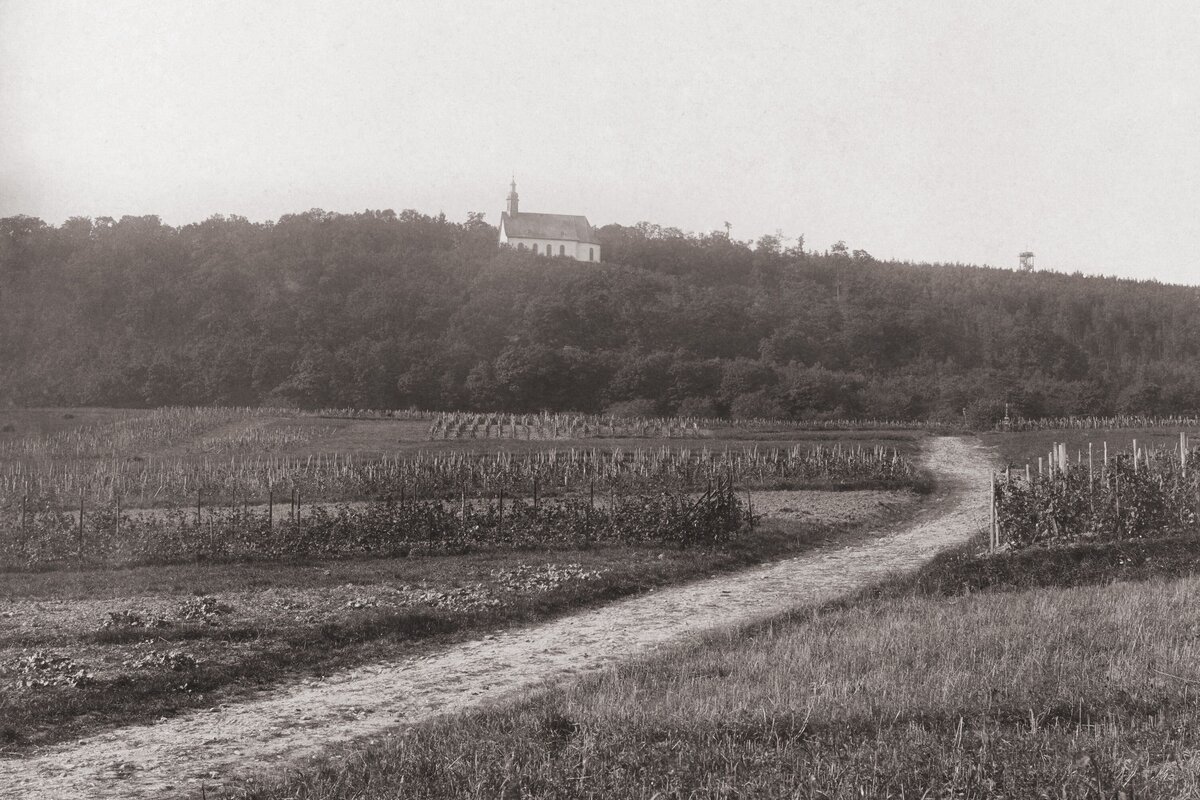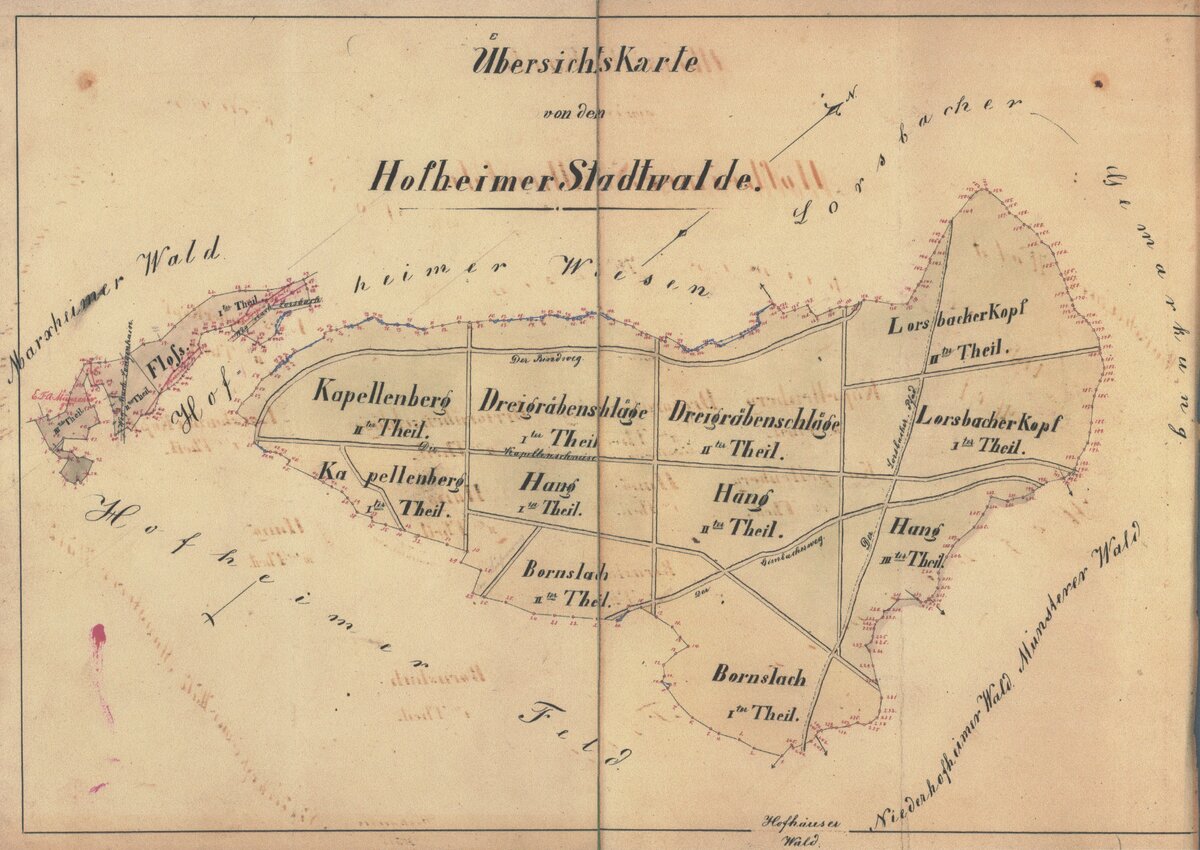Forest in Hofheim
The total area of forest in Hofheim is 2,372 ha and the operational area of the municipal forest is approximately 1,414 ha. Of this, 1,395 ha are tree stands. 8.7% of the operational area is "forest not in regular use".
There are significant areas of forest in all districts:
- Marxheim: 266.4 ha
- Hofheim: 469.8 ha
- Lorsbach: 156.3 ha
- Langenhain: 201.1 ha
- Wildsachsen: 104.8 ha
- Diedenbergen: 182.8 ha
- Wallau: 80.1 ha
The largest contiguous forest area is the Kapellenberg with an area of around 520 ha.
The importance of the municipal forest as a local recreation area and "leisure park" for the population in the Rhine-Main conurbation is immense.
The forest has above-average accessibility thanks to a well-developed network of paths. The average length of paths is 40 to 50 meters per hectare.
According to the current forestry survey, the average volume in the forest is 319 solid cubic meters per hectare (Vfm/ha). This means that it is slightly understocked compared to the national average (326 Vfm/ha). The forest is predominantly characterized by old and medium-aged stands.
The ratio of hardwood to softwood is 81:16. The report on the Hofheim municipal forest 2021 lists the following tree species and their proportions in the municipal forest:
| Tree species | Percentage |
|---|---|
| Beech | 36 % |
| Oak | 34 % |
| Noble hardwood (maple, ash, cherry, etc.) | 6 % |
| Softwood (birch, poplar, etc.) | 5% |
| pine | 6 % |
| larch | 4 % |
| spruce | 3 % |
| Douglas fir | 3 % |
Whether beech, spruce or Douglas fir: they are all an important part of the mixed forest in Hofheim. The different soil and growth requirements of the species help to maintain the municipal forest in the future.
Old, large-crowned oaks characterize the urban forest. They are less demanding of the soil, but require light and are slow-growing. In coppicing, a type of historical "agro-forestry", weak wood was used as firewood, while the old oaks were left to fatten the pigs in the forest with their nutritious fruit (acorns, "Eckerich") (forest pasture). The "remnants" of this form of farming can be seen in our old oaks. More recently, oak has been increasingly reforested, as it is valued as valuable furniture wood and is also robust and less susceptible to storms and drought.
Spruce is the best known coniferous tree species and was not part of the original natural forest community of the urban forest. Spruce now only makes up around 3% of the urban forest. After the completion of the large-scale afforestations in the middle and end of the 19th century, it was around 20%. It is an undemanding and fast-growing tree species. It was therefore particularly suitable for the reforestation of devastated forest areas after the great timber shortage in the 18th century. The spruce was intended to ensure the supply of wood for the national economy.
However, it is only partially adapted to our locations. Increasing global warming combined with persistent summer drought have taken their toll. Storms and bark beetles did the rest.
Thanks to its frugality in terms of water, soil and climate, the resin-rich Scots pine is still an important tree species in the urban forest and can be found in almost all districts. It grows predominantly as a stand-forming tree on dry sites or in rocky locations. In the past, it was often used to reforest wasteland. However, its share is decreasing as it is not competitive enough, especially against beech.
Douglas fir has been the focus of forestry cultivation trials in Europe for almost 200 years. In addition to its long history of cultivation and its important role for the timber industry in Germany, the tree species is considered a potentially invasive species and is subject to criticism. However, forestry scientists regard Douglas fir as the most important introduced tree species and, compared to spruce, it is more drought-resistant and less susceptible to damage from bark beetles. In addition to the favorable forecasts with regard to emerging climate change, the tree species is important for forestry due to the many years of research-based findings. With regard to its invasiveness and suitability for cultivation, however, Douglas fir will still be the subject of much debate and will have to prove in the future that its cultivation - also as a replacement for spruce - is justified.
The urban forest is extremely species-rich. In addition to the main tree species mentioned above, there are silver fir, European larch, sycamore and Norway maple, ash, wild cherry, wych elm, birch and small-leaved lime. Rare tree species, such as wild service tree, speierling, wild pear, wild apple and exotic species such as coastal fir and strobe can also be found in the city forest. Special features include the centuries-old oaks on the Kapellenberg and the largest wild apple in Hesse in Diedenbergen.
The Hofheim forest is located in the "Südlicher Vorder-Taunus" growth district with above-average sites. The nutrient supply is mostly medium, in large parts with thick loess loam blankets also very good.
The water supply of the soils is fresh to markedly fresh on around three quarters of the sites.
The climatic conditions are mild, the average annual temperature is 9.6 °C (long-term average), with below-average precipitation, which, however, increases from the lowlands (615 mm) on the edge of the Rhine-Main plain to the mountain ranges (730 mm).
The prevailing site conditions in the urban forest ensure good to very good plant growth and enable species-rich mixed forests.
The municipal forest was not always as we know it today. Would you have thought that there was a time when almost the entire area of our town was covered by dense forests? And that just a few centuries later, one of the city's most pressing problems was the dwindling supply of wood?
Forests always reflect the history of mankind. And if you look closely, perhaps the forest will also reveal one of its secrets to you.
Until 10,000 years ago, at the end of the Würm Ice Age, parts of the Taunus were covered by glaciers. With increasing warming, the ice released the hilltops and the mountain forests that settled there changed from mixed spruce forests to beech-fir forests. In the warmer Rhine-Main plain, oak-rich mixed deciduous forests developed, consisting mainly of English oak, lime, elm, Norway maple, alder and ash. This forest development, largely uninfluenced by humans, came to an end around 500 BC. It is assumed that without the subsequent centuries of human influence, today's forests in the Hofheim district would be very similar to those of that time ("potentially natural forest").
Since the early Middle Ages, wood has become the central raw material in almost all areas of human life. This also had an increasingly intensive impact on forest development. Emerging industries such as mining, the operation of smelting furnaces, charcoal works, glassworks and other forestry trades, as well as the firewood requirements of households, consumed huge quantities of wood.
The size and appearance of the urban forest are still influenced by this today. For a long time, the unimaginable devastation was so severe that the forest looked more like a parkland or pasture than a forest as we know it today.
At the end of the 18th century, when it became increasingly difficult for the people of Hofheim to obtain wood from their own forest, sustainability was born: from then on, only as much wood could be used as would grow back. Did you know that the "sustainable development" that has been widely propagated since the 1992 Rio de Janeiro environmental conference can ultimately be traced back to the forestry industry of the time?
In Germany, hunting is only practiced in hunting districts. Hunting districts are divided into private hunting districts and communal hunting districts, depending on their size and owner objectives.
There are communal hunting districts in Hofheim and in all parts of the city. These form hunting cooperatives in which the landowners on whose land hunting can be practiced are represented. The city of Hofheim is one of the members of the hunting cooperatives, with the largest share of woodland. The hunting rights for the individual areas are leased to one or more persons by the hunting cooperative.
At its meeting on 11.12.2019, the municipal council adopted a hunting concept for the Hofheim municipal forest. Since April 1, 2021, new contracts with expanded and amended content have been concluded between the hunting cooperatives in the Hofheim municipal area as landlords and the hunting tenants when the old contracts expire. The first new lease agreement was concluded by the Hofheim am Taunus hunting cooperative.
In particular, the criteria relevant to FSC certification were included. To this end, constant communication between foresters, farmers and hunting leaseholders has been agreed in order to coordinate the focus of hunting, for example on clear-cut areas and regeneration sites.
In addition to regulating game populations, which in particular aims to ensure that game populations are adapted to the capacity of the forest and enable natural regeneration, hunting also serves the purpose of game management. According to the Federal Hunting Act, the conservation of species-rich and healthy game populations and the safeguarding of their livelihoods is formulated as the aim of game management.
Further facts and figures
Since 2020, the city of Hofheim has provided annual information on the condition of the forest and on the topics of "commercial forest" (logging and sale, maintenance measures, planting and more), the "recreational forest" and the "protective forest" (nature conservation, campaigns, wildlife situation).
Hofheim's municipal forest is managed according to the principles of sustainability and economic efficiency (economic principle). The city of Hofheim was awarded the PAN European Forest Certification (PEFC) for this sustainable and ecological management of the city forest.
Founded in Paris in 1999. All state forests in Germany are PEFC certified. The seal is intended to imply responsible and particularly environmentally and socially compatible forest management for products.
It is an opportunity for forest owners and foresters to document and improve their sustainable management practices.

